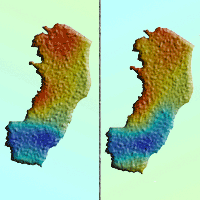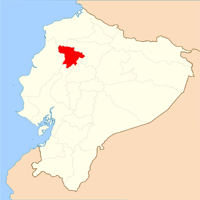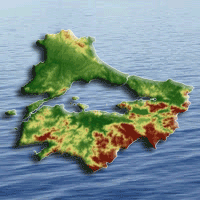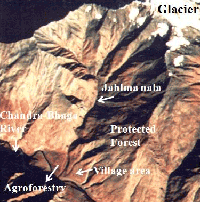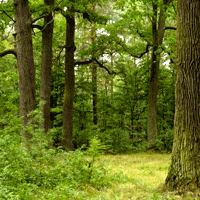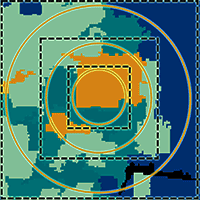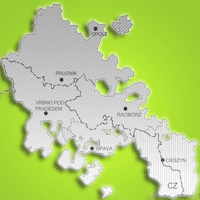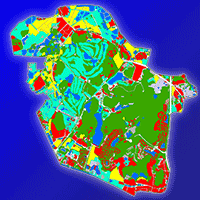The relationship between forest cover and streamflow of watersheds is complex and still controversial in the scientific literature. To investigate suchrelationship we propose an alternative method which requires the following information for each watershed: percentage of forest cover, annual rainfall, average specific streamflow (qave), and minimum mean specific streamflow in seven consecutive days (q7). As a case study, we analyzed a dataset composed by 25 watersheds located in the Espírito Santo State (ESS), Brazil. We conducted simple and multiple linear regression analyses as well as partial correlation analysis between the above parameters. To reduce the effect of heterogeneity of environmental factors, watersheds with similar characteristics in term of rainfall, drainage area, and both rainfall and drainage area were grouped by cluster analysis, and the above regression and correlation analysis was repeated on each group. Our results using the whole dataset showed that forest cover has a negative relationship with watershed streamflow. The analysis of homogeneous groups of watersheds showed that the average minimum streamflow during seven days (q7) was more sensitive to the presence of forest cover, showing a negative relationship, especially in watersheds with low annual rainfall, while in areas with high precipitation, the annual rainfall showed a strong influence on the hydrological responses of watersheds, masking the effect of forest cover. The proposed method may be easily extended to other areas, and allowsthe inclusion of other relevant environmental variables according to specific cases.
Keywords
, , , ,
Citation
Ferraz FT, Zanetti SS, Cecílio RA, De Carvalho D, De Oliveira FR (2021). Method for the analysis of the relationship between forest cover and streamflow in watersheds. iForest 14: 344-352. - doi: 10.3832/ifor3536-014
Academic Editor
Raffaele Lafortezza
Paper history
Received: May 28, 2020
Accepted: May 24, 2021
First online: Jul 21, 2021
Publication Date: Aug 31, 2021
Publication Time: 1.93 months
© SISEF - The Italian Society of Silviculture and Forest Ecology 2021
Open Access
This article is distributed under the terms of the Creative Commons Attribution-Non Commercial 4.0 International (https://creativecommons.org/licenses/by-nc/4.0/), which permits unrestricted use, distribution, and reproduction in any medium, provided you give appropriate credit to the original author(s) and the source, provide a link to the Creative Commons license, and indicate if changes were made.

Breakdown by View Type
(Waiting for server response...)
Article Usage
Total Article Views: 34195
(from publication date up to now)
Breakdown by View Type
HTML Page Views: 28985
Abstract Page Views: 2395
PDF Downloads: 2275
Citation/Reference Downloads: 3
XML Downloads: 537
Web Metrics
Days since publication: 1606
Overall contacts: 34195
Avg. contacts per week: 149.04
Article Citations
Article citations are based on data periodically collected from the Clarivate Web of Science web site
(last update: Mar 2025)
Total number of cites (since 2021): 1
Average cites per year: 0.20
Publication Metrics
by Dimensions ©
Articles citing this article
List of the papers citing this article based on CrossRef Cited-by.
(1)
Alvares CA, Stape JL, Sentelhas PC, Gonçalves JLM, Sparovek G (2013)Köppen’s climate classification map for Brazil. Meteorologische Zeitschrift 22: 711-728.
CrossRef |
Gscholar
(2)
ANA (2017)Conjuntura dos recursos hídricos no Brasil: relatório pleno [Water resources situation in Brazil: full report]. ANA, Brasilia, Brazil, pp. 169. [in Portuguese]
Online |
Gscholar
(3)
Anderson CJ, Lockaby BG (2011)The effectiveness of forestry best management practices for sediment control in the Southeastern United States: a literature review. Southern Journal of Applied Forestry 35: 170-177.
CrossRef |
Gscholar
(4)
Andréassian V (2004)Waters and forests: From historical controversy to scientific debate. Journal of Hydrology 291: 1-27.
CrossRef |
Gscholar
(5)
Awange JL, Mpelasoka F, Goncalves RM (2016)When every drop counts: analysis of droughts in Brazil for the 1901-2013 period. Science of the Total Environment 566-567 (7): 1472-1488.
CrossRef |
Gscholar
(6)
Awotwi A, Anournu GK, Quaye-Ballard JA, Anoor T, Forkuo EK, Harris E, Agyekum J, Terlabie JL (2019)Water balance responses to land-use/land-cover changes in the Pra River Basin of Ghana, 1986-2025. Catena 182: 1-13.
CrossRef |
Gscholar
(7)
Bosquilia RWD, Neale CMU, Duarte SN, Longhi SJ, Ferraz SFB, Muller-Karger FE, Mccarthy MJ (2018)Evaluation of evapotranspiration variations as a function of relief and terrain exposure through multivariate statistical analysis. Ecohydrology and Hydrobiology 19: 307-315.
CrossRef |
Gscholar
(8)
Brown AE, Zhang L, McMahon TA, Western AW, Vertessy RA (2005)A review of paired catchment studies for determining changes in water yield resulting from alterations in vegetation. Journal of Hydrology 310: 28-61.
CrossRef |
Gscholar
(9)
Brown AE, Western AW, McMahon TA, Zhang L (2013)Impact of forest cover changes on annual streamflow and flow duration curves. Journal of Hydrology 483: 39-50.
CrossRef |
Gscholar
(10)
Bruijnzeel LA (1989)(De)forestation and dry season flow in the tropics: a closer look. Journal of Tropical Forest Science 1: 229-243.
Online |
Gscholar
(11)
Bruijnzeel LA (1990)Hydrology of moist tropical forests and effects of conversion: a state of knowledge review. UNESCO International Hydrological Programme, Paris, France, pp. 230.
Online |
Gscholar
(12)
Bruijnzeel LA (2004)Hydrological functions of tropical forests: not seeing the soil for the trees? Agriculture, Ecosystems and Environment 104: 185-228.
CrossRef |
Gscholar
(13)
Chambers JQ, Artaxo P (2017)Biosphere-atmosphere interactions: deforestation size influences rainfall. Nature Climate Change 7: 175-176.
CrossRef |
Gscholar
(14)
Chaves LCG, Lopes FB, Maia ARS, Meireles ACM, Andrade EM (2019)Water quality and anthropogenic impact in the watersheds of service reservoirs in the Brazilian semi-arid region. Revista Ciência Agronômica 50: 223-233.
Online |
Gscholar
(15)
Cheng B, Li H, Yue S, Huang K (2019)A conceptual decision-making for the ecological base flow of rivers considering the economic value of ecosystem services of rivers in water shortage area of Northwest China. Journal of Hydrology 578: 1-7.
CrossRef |
Gscholar
(16)
Cunha AP, Marengo JA, Alvala RC, Deusdara-Leal KR, Cuartas LA, Seluchi M, Zeri M, Ribeiro-Neto G, Brodel E, Cunningham C, Costa L, Moraes OLL (2019)Secas e seus impactos no Brasil em 2018 [Droughts and their impacts in Brazil in 2018]. CEMADEN, São José dos Campos, SP, Brazil, pp. 19. [in Portuguese]
Online |
Gscholar
(17)
Dias LCP, Macedo MN, Costa MH, Coe MT, Neill C (2015)Effects of land cover change on evapotranspiration and streamflow of small catchments in the Upper Xingu River Basin, Central Brazil. Journal of Hydrology: Regional Studies 4: 108-122.
CrossRef |
Gscholar
(18)
Ferreira VG, Montecino HC, Ndehedehe CE, Heck B, Gong Z, Freitas SRC, Westerhaus M (2018)Space-based observations of crustal deflections for drought characterization in Brazil. Science of the Total Environment 644: 256-273.
CrossRef |
Gscholar
(19)
Ghimire CP, Bruijnzeel LA, Lubczynski MW, Bonell M (2014)Negative trade-off between changes in vegetation water use and infiltration recovery after reforesting degraded pasture land in the Nepalese Lesser Himalaya. Hydrology and Earth System Sciences 18: 4933-4949.
CrossRef |
Gscholar
(20)
Giri S, Arbab NN, Lathop RG (2018)Water security assessment of current and future scenarios through an integrated modeling framework in the Neshanic River watershed. Journal of Hydrology 563: 1025-1041.
CrossRef |
Gscholar
(21)
Governo do Estado do Espírito Santo (2020)PEPDEC - Plano estadual de proteção e defesa civil do Espírito Santo [PEPDEC - State plan for protection and civil defense of Espírito Santo]. Vitória, ES, Brazil, pp. 71. [in Portuguese]
Online |
Gscholar
(22)
Guzha AC, Rufino MC, Okoth S, Jacobs S, Nobrega RLB (2018)Impacts of land use and land cover change on surface runoff, discharge and low flows: evidence from East Africa. Journal of Hydrology: Regional Studies 15: 49-67.
CrossRef |
Gscholar
(23)
Hellweger F (1997)AGREE - DEM surface reconditioning system. Web site.
Online |
Gscholar
(24)
Hewlett JD, Lull HW, Reinhart KG (1969)In defense of experimental watersheds. Water Resources Research 5: 306-316.
CrossRef |
Gscholar
(25)
Hornbeck JW, Adams MB, Cobett ES, Verry ES, Lynch A (1993)Long-term impacts of forest treatments on water yield: a summary for northeastern USA. Journal of Hydrology 150: 323-344.
CrossRef |
Gscholar
(26)
Krishnaswamy J, Bonell M, Venkatesh B, Purandara BK, Rakesh KN, Lele S, Kiran MC, Reddy V, Badiger S (2013)The groundwater recharge response and hydrologic services of tropical humid forest ecosystems to use and reforestation: support for the “infiltration-evapotranspiration trade-off hypothesis”. Journal of Hydrology 498: 191-209.
CrossRef |
Gscholar
(27)
Laurance WF, Williamson GB (2001)Positive feedbacks among forest fragmentation, drought, and climate change in the Amazon. Conservation Biology 15: 1529-1535.
CrossRef |
Gscholar
(28)
Lawrence D, Vandecar K (2015)Effects of tropical deforestation on climate and agriculture. Nature Climate Change 5: 27-36.
CrossRef |
Gscholar
(29)
Mello K, Valente RA, Randhir TO, Vettorazzi A (2018)Impacts of tropical forest cover on water quality in agricultural watersheds in southeastern Brazil. Ecological Indicators 93: 1293-1301.
CrossRef |
Gscholar
(30)
Mello CR, Avila LF, Lin H, Terra MCNS, Chappell NA (2019)Water balance in a neotropical forest catchment of southeastern Brazil. Catena 173: 9-21.
CrossRef |
Gscholar
(31)
Mendes NGS, Cecílio RA, Zanetti SS (2018)Forest coverage and streamflow of watersheds in the tropical Atlantica rainforest. Revista Arvore 42: 2-10.
CrossRef |
Gscholar
(32)
Neary D (2016)Long-term forest paired catchment studies: what do they tell us that landscape-level monitoring does not? Forests 7: 1-15.
CrossRef |
Gscholar
(33)
Nikolic G, Spalevic V, Curovic M, Khaledi Darvishan A, Skataric G, Pajic M, Kavian A, Tanaskovik V (2019)Variability of soil erosion intensity due to vegetation cover changes: case study of Orahovacka Rijeka, Montenegro. Notulae Botanicae Horti Agrobotanici Cluj-Napoca 47: 237-248.
CrossRef |
Gscholar
(34)
Peña-Arancibia JL, Bruijnzeel LA, Mulligan M, Van Dijk AIJM (2019)Forests as “sponges” and “pumps”: assessing the impact of deforestation on dry-season flows across the tropics. Journal of Hydrology 574: 946-963.
CrossRef |
Gscholar
(35)
Roa-García MC, Brown S, Schreier H, Lavkulich LM (2011)The role of land use and soils in regulating water flow in small headwater catchments of the Andes. Water Resources Research 47: 1-12.
CrossRef |
Gscholar
(36)
Sadeghi SH, Hazbavi Z, Gholamalifard M (2019)Interactive impacts of climatic, hydrologic and anthropogenic activities on watershed health. Science of the Total Environment 648: 880-893.
CrossRef |
Gscholar
(37)
Salazar JF, Villegas JC, Rendón AM, Rodríguez E (2018)Scaling properties reveal regulation of river flows in the Amazon through a “forest reservoir”. Hydrology and Earth System Sciences 22: 1735-1748.
CrossRef |
Gscholar
(38)
Santos EHM, Griebeler NP, Oliveira LFC (2010)Relação entre o uso do solo e comportamento hidrológico na Bacia Hidrográfica do Ribeirão João Leite [Relationship between land use and hydrologic behavior in the Ribeirão João Leite Basin]. Revista Brasileira de Engenharia Agrícola e Ambiental 14: 826-834. [in Portuguese]
CrossRef |
Gscholar
(39)
Schenk ER, O’Donnel F, Springer AE, Stevens LE (2020)The impacts of tree stand thinning on groundwater recharge in aridland Forests. Ecological Engineering 145: 1-11.
CrossRef |
Gscholar
(40)
Shiklomanov IA (1993)World fresh water resources. In: “Water in Crisis: a Guide to the World’s Fresh Water Resources” (Gleick PH ed). Oxford University Press, Oxford, UK, pp. 13-24.
Gscholar
(41)
Silva KR, Cecílio RA, Xavier AC, Pezzopane JRM, Garcia GO (2011)Interpolação espacial da precipitação no estado do Espírito Santo [Spatial interpolation of precipitation in Espírito Santo state]. Floresta e Ambiente 18: 417-427. [in Portuguese]
CrossRef |
Gscholar
(42)
Tu M, Hall MJ, De Laat PJM, De Wit MJM (2004)Detection of long-term changes in precipitation and discharge in the Meuse basin. GIS and Remote Sensing in Hydrology, Water Resouces and Environment. IAHS Publications 289: 169-177.
Online |
Gscholar
(43)
Tucci CEM, Clarke RT (1997)Impacto das mudanças da cobertura vegetal no escoamento: revisão [Impact of vegetation cover changes on outflow: review]. Revista Brasileira de Recursos Hídricos 2: 135-152. [in Portuguese]
CrossRef |
Gscholar
(44)
Wang H, Asefa T, Bracciano D, Adams A, Wanakule N (2019)Proactive water shortage mitigation integrating system optimization and input uncertainty. Journal of Hydrology 571: 711-722.
CrossRef |
Gscholar
(45)
Ward H Jr (1963)Hierarchical grouping to optimize an objective function. Source Journal of the American Statistical Association 58: 236-244.
CrossRef |
Gscholar
(46)
Wright JS, Fu R, Worden JR, Chakraborty S, Clinton NE, Risi C, Sun Y, Yin L (2017)Rainforest-initiated wet season onset over the southern Amazon. Proceedings of the National Academy of Sciences USA 114: 8481-8486.
CrossRef |
Gscholar
(47)
Xavier AC, King CW, Scanlon BR (2016)Daily gridded meteorological variables in Brazil (1980-2013). International Journal of Climatology 36: 2644-2659.
CrossRef |
Gscholar
(48)
Zabaleta A, Garmendia E, Mariel P, Tamayo I, Antiguedad I (2018)Land cover effects on hydrologic services under a precipitation gradient. Hydrology and Earth System Sciences 22: 5227-5241.
CrossRef |
Gscholar
(49)
Zhang L, Dawes W, Walker G (2001)Response of mean annual evapotranspiration to vegetation changes at catchment scale. Water Resources Research 37: 701-708.
CrossRef |
Gscholar
(50)
Zhang M, Liu N, Harper R, Li Q, Liu K, Wei X, Ning D, Hou Y, Liu S (2017)A global review on hydrological responses to forest change across multiple spatial scales: importance of scale, climate, forest type and hydrological regime. Journal of Hydrology 546: 44-59.
CrossRef |
Gscholar
